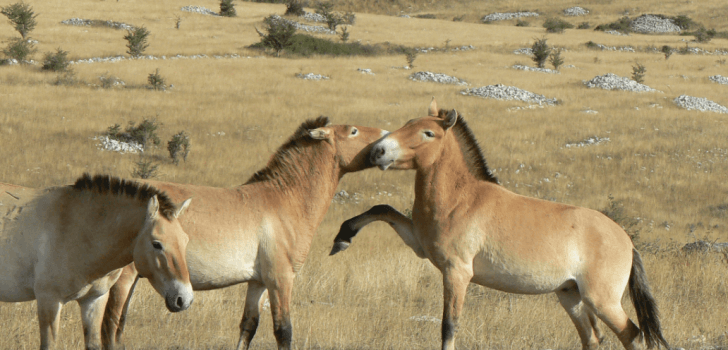The Przewalski horse, which once roamed the Mongolian Steppes but was brought to the brink of extinction, is making a sure but steady return to their original homeland. The Przewalski is regarded as one of the remaining true species of wild horse in the world.
Until just a few years ago, the breed was confined to zoos and reserves in Mongolia and China, but through very selective breeding programs, the stocky, scrubby horses are finally returning to their wild natural environment.
Although other breeds of feral horses, like the Australian Brumby and American Mustang, are often referred to as “wild”, they are actually the descendants of domesticated horses.
Claudia Feh, director of the Association for the Przewalski’s horse says the breed is sacred and symbolic to the local people of Mongolia, once being revered by Mongolians as spiritual messengers.
The Przewalski’s stands about four feet tall at the shoulder, are muscular, with a scrubby, short mane that sticks straight up.
They once roamed freely from the Russian Steppes to Northern China and Kazakhstan, but by the 1960s had all but disappeared because encroaching human settlements, extreme winter weather, and even hunting nearly wiped them out.
At their lowest point, only 12 Przewalski’s horses survived, with the International Union for Conservation of Nature listing them as “extinct in the wild.”
But now thanks to the aggressive breeding program, there are 2,000 Przewalski’s horses worldwide, with about 350 being returned to live on reserves in Mongolia.
Ernest Bailey, a University of Kentucky researcher says, “Apparently even 12 horses have a lot of genetic variation and the broader lesson is that we should not give up on a species…we should not abandon them to extinction as long as there is a breeding pair.”
However, even though the Przewalski is beginning to return to the wild, they still face severe threats to long-term survival. Although the 12 surviving horses had enough diversity of genes to bring them back from the brink, their descendants are now vulnerable to diseases from inbreeding.
There is a risk that the horses could breed themselves out of existence if they mate naturally with feral horses that are descendents from domesticated stock, and the newly rewilded horses will still have to survive the harsh Mongolian winters.
Stay Connected
Comments are closed.